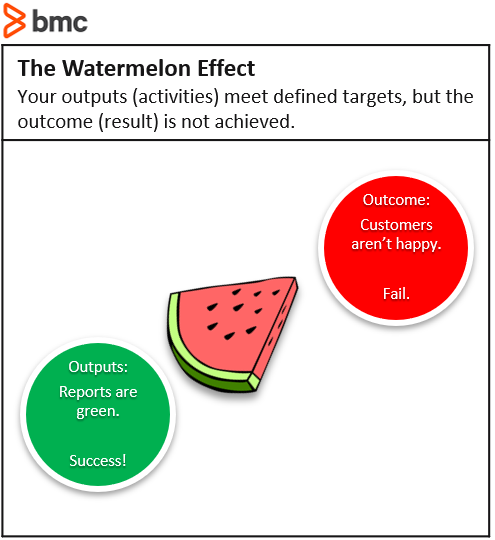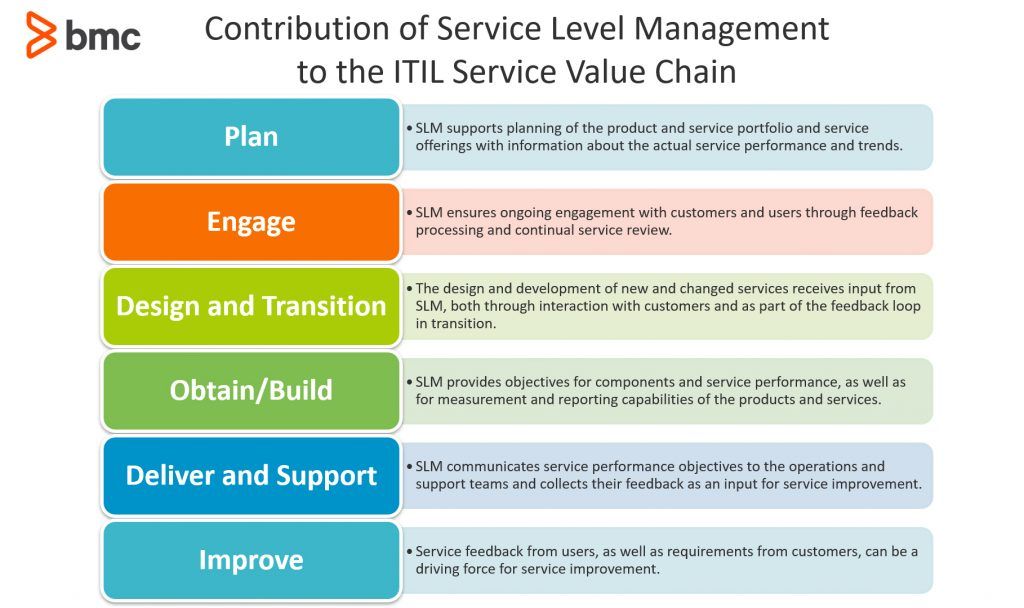What Are The Outputs Of Service Level Management
The practice of Service Level Direction (SLM) gives assurance to the service consumer that a provider will deliver a level of service that meets their needs.
The purpose of the SLM exercise is to fix articulate business-based targets for service performance, so that the commitment of a service can be properly assessed, monitored, and managed confronting these targets. SLM involves service level activities, including:
- Defining service levels
- Documenting
- Actively managing them
(This article is function of our ITIL 4 Guide. Employ the correct-hand menu to navigate.)
Download Now: ITIL four Best Practice east-Books
These all-new for 2020 ITIL eastward-books highlight important elements of ITIL 4 best practices. Quickly sympathise key changes and actionable concepts, written by ITIL four contributors.

Service Level Agreements (SLAs)
An SLA is divers as a documented agreement between a service provider and a customer that identifies both services required and the expected level of service.
SLAs are used to mensurate the performance of services from the customer's point of view, and it is of import that they are agreed in the wider business context.
Some of the key requirements for successful SLAs include:
- They must exist related to a defined 'service' in the service catalogue. Individual metrics without a specified service context are unhelpful.
- They should chronicle to defined outcomes and not simply operational metrics. This tin exist accomplished with balanced bundles of metrics, such every bit client satisfaction and central business organization outcomes.
- They should reflect an 'understanding': an appointment and discussion betwixt the service provider and the service consumer. It is of import to involve all stakeholders, including partners, sponsors, users, and customers.
- They must be merely written and like shooting fish in a barrel to understand and utilize for all parties.
The "Watermelon SLA Effect"
The ITIL 4 Foundation guide describes an effect whereby a service provider's metrics are consistently coming together defined targets, simply the customers are:
- Dissatisfied with the service received
- Frustrated that the provider doesn't notice this
Usually this happens when the service provider misses out on significant business functionalities and outcomes which are important to the consumer. Therefore there is a mismatch between the customer'south perception of the service and the provider'southward view of service performance.
For example, a service provider might report 99.9% uptime; however the 0.01% downtime happened at the most critical fourth dimension for the customer'southward business causing pregnant damage to financials and reputation, all the same the service provider downplays the effect of that particular downtime. In this particular example, the service provider is focused more on availability metrics rather than customer experience.

The result is that while the service provider's dashboards might visualize their performance as light-green, the customer'southward experience is more akin to "red condition". The name "watermelon effect" is invoked by this color upshot: like a watermelon, the SLA is light-green on the outside, and carmine on the inside.
SLM needs to place metrics and measures that are a truthful reflection of the customer's actual experience and level of satisfaction with the whole service. And because these will vary across organizations, the simply way to learn what these are is to notice out direct from customers.
SLM: Appoint and Mind
In order to be aligned to customer outcomes and expectations, SLM requires focus and attempt to engage and listen to the requirements, problems, concerns, and daily needs of customers:
- Date is needed to understand and confirm the actual ongoing needs and requirements of customers, not simply what is interpreted past the service provider or has been agreed several years before. ITIL4 refers to value as being co-created, since it needs the input and validation of customers.
- Listening is important as a human relationship-building and trust-building activity, to evidence customers that they are valued and understood. This helps to move the provider away from always being in 'solution manner' and to build new, more constructive partnerships. Each customer is unique, and the service provider must not accept a 1-size-fits-all arroyo.
The activities of engaging and listening provide a great opportunity to build improved relationships and to focus on what really needs to be delivered. They also give service delivery staff an experience-based agreement of the day-to-day work that is done with their technology, enabling them to deliver a more than business concern-focused service. When the client is engaged and listened to, they feel valued and their perception of the service and service management activities improves.
SLM Information Sources
SLM involves collating and analysing information from a number of sources including:
- Customer Engagement: This involves initial listening, discovery, and information capture on which to base of operations metrics, measurement, and ongoing progress discussions through simple open ended questions on topics such as the what the client uses the service for, the expected outcomes and how the service provider tin help reach the outcomes.
- Customer Feedback: This is ideally gathered from a number of sources, both formal and informal, including satisfaction surveys and key concern-related measures such equally SLAs and KPIs.
- Operational Metrics: These are the depression-level indicators of diverse operational activities and may include measures such as availability, response times, resolution times, and processing times.
- Business organisation Metrics: These can exist any business activeness that is deemed useful or valuable past the client and used as a means of gauging the success of the service. Examples inlclude customer registration, billing, and transaction completion.
Once this feedback is gathered and collated for ongoing review, it can exist used as input to blueprint suitable measurement and reporting models and practices.
Required SLM Skills and Competencies
The skills and competencies for SLM include relationship management, business liaison, business concern analysis, and commercial/supplier management due to the emphasis on engagement with the customer and all stakeholders involved in service direction. Therefore, a holistic approach which focuses on the whole service and not just its elective parts is required. Simple individual metrics (such equally per centum system availability) should not be taken to correspond the whole service level, rather a view that incorporates customer perception and business outcomes must be the standard arroyo to SLM.
Contribution of Service Level Management to the Service Value Chain
Service Level Direction is involved in all service value chain activities (mainly program and appoint ) equally shown below:
| Plan | SLM supports planning of the product and service portfolio and service offerings with information virtually the bodily service performance and trends. |
| Engage | SLM ensures ongoing appointment with customers and users through feedback processing and continual service review. |
| Design and Transition | The design and evolution of new and changed services receives input from SLM, both through interaction with customers and as part of the feedback loop in transition. |
| Obtain/Build | SLM provides objectives for components and service operation, every bit well as for measurement and reporting capabilities of the products and services. |
| Deliver and Support | SLM communicates service performance objectives to the operations and support teams and collects their feedback as an input for service improvement. |
| Improve | Service feedback from users, as well every bit requirements from customers, can be a driving strength for service improvement. |

ITIL® is a registered trade mark of AXELOS Limited. IT Infrastructure Library® is a registered merchandise mark of AXELOS Limited.
Related reading
- BMC Service Management Blog
- SLA All-time Practices for ITIL
- Service Level Agreement (SLA) Templates & Examples
- A Primer on Service Level Indicator (SLI) Metrics
- SLAs vs OLAs: Comparing Service and Operational Agreements
ITIL 4 All-time Exercise east-books
These all-new ITIL e-books highlight important elements of ITIL 4 best practices so that yous can speedily sympathize primal changes and actionable concepts. Download now for free!

These postings are my own and do non necessarily correspond BMC'due south position, strategies, or opinion.
See an error or have a suggestion? Please let u.s. know by emailing blogs@bmc.com.
BMC Brings the A-Game
BMC works with 86% of the Forbes Global 50 and customers and partners around the world to create their future. With our history of innovation, industry-leading automation, operations, and service management solutions, combined with unmatched flexibility, we help organizations free up fourth dimension and infinite to become an Autonomous Digital Enterprise that conquers the opportunities ahead.
Learn more well-nigh BMC ›
What Are The Outputs Of Service Level Management,
Source: https://www.bmc.com/blogs/itil-service-level-management/
Posted by: powellreadeary.blogspot.com



0 Response to "What Are The Outputs Of Service Level Management"
Post a Comment